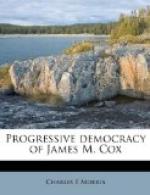Nor has capital been offended by the methods pursued. This fact is attested by statements of those who speak for invested industrial wealth. Thus, W. S. Thomas, of Springfield, says that the policies pursued have made “Ohio an oasis in the widespread area of industrial turmoil during and since the great war.”
There are cited, too, the conclusions reached by Thomas J. Donnelly, Secretary of the Ohio Federation of labor, who has written:
“Labor has confidence in James M. Cox because the laboring people feel that he understands their needs and is in hearty sympathy with the progressive aspirations of those who earn their bread by the sweat of their brows. As governor, he accomplished more in the interest of the laboring people of Ohio and is held in higher esteem by them than any other governor in the state’s history.
“He has done much to avoid and to settle labor troubles. He believes that more can be accomplished through reason and common sense than through force and intimidation; and whenever called upon to send the militia to deal with striking workmen, he always found a way to prevent violence and preserve order without using soldiers for that purpose. During the big steel strike when violence and disorder were rampant in some states where the right peaceably to assemble had been denied to the striking workers, in Ohio, where there were equally as many strikers involved, there was no sign of violence, and the right of workers peaceably to assembled was not interfered with. If his policy had been followed by other public officials throughout the nation, there would be less unrest and the people would have more confidence in the fairness of government authorities.”
It is only necessary to get a comprehensive view of Governor Cox’s record with respect to labor troubles to tell the plain story of what he has done. He had scarce taken hold as Governor in 1913 when a strike broke out in the great rubber plants of Akron. It seemed to have been fomented by members of the Industrial Workers of the World, but it drew in its train thousands upon thousands of other workers until the great plants were practically idle. In Akron, where a heterogenous collection of industrial workers dwell, idleness was a potent factor in fomenting disorder. The normal course of affairs would have been an attempt to operate the plants with strike breakers under guard, provocative acts upon both sides, and finally, recourse to an armed militia to quell the disorder after the inevitable bloodshed had ensued. Although new in executive experience, Governor Cox took another course. He sent trained and trusted investigators to Akron who learned the facts and reported to him accurately upon the situation, including also the grievances of the toilers. At the same time he gave warning to the local authorities that they preserve a strict neutrality in their dealing with the contending forces, and he uttered a solemn warning that the laws must




